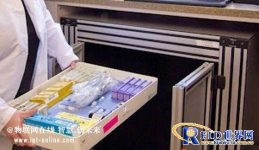
The University of Maryland Medical Center adopts RFID solutions to ensure the quality of emergency medicine supply
[ad_1]
The University of Maryland Medical Center began adopting the solution in April this year. The use of the RFID system not only helps medical staff better manage emergency medicines, but also helps statistics on medicine inventory information. Of course, the biggest benefit of the hospital’s RFID solution is to greatly reduce the occurrence of drug management errors and effectively eliminate the adverse consequences caused by human factors.
The University of Maryland Medical Center is located in Baltimore, the largest city in Maryland, USA. The center has 750 beds. The hospital’s pharmacy is adopting RFID solutions to ensure the quality of emergency medicine supply. The RFID solution is provided by Kit Check. By adopting this system, medical staff can accurately understand the types of medicines in each tray (as shown in the figure below), as well as the use of medicines, whether they have reached the expiration date, and other information. This solution greatly improves the efficiency of medical staff in organizing medicines, reducing the organizing time from the previous 20 minutes to less than 5 minutes, saving 75% of the time.
Emergency medicines are mainly used for patients suffering from heart disease or acute allergic reactions. Each tray (as shown in the picture) contains 25-50 different kinds of medicines, which are sealed with plastic film. After use, you need to take the medicine to the pharmacy to replenish the medicine, or take out the medicine that is not used, and record the expiration time of the medicine.

Place the tray containing a variety of medicines into the scanning cart, and the built-in RFID reader can identify the type of medicine and its shelf life
In April this year, the hospital implemented the RFID solution. Prior to this, the shelf life testing of the medicines in the trays was manually recorded; in order to prevent errors, two medical personnel were sent to perform them separately.
This machine provided by Kit Check for the hospital is called Kit Check scanner with built-in RFID reader. Each tray is affixed with an EPC Gen 2 passive UHF RFID tag. In addition, each medicine is also labeled. The code of the label on the tray is associated with the code of the drug label. Put the tray in it, press the “Scan” button to start reading the medicines and the labels on the tray. After the “scanning” is completed, information such as which drugs have been changed, which drugs are about to expire, and which drugs have been updated, can all receive valid answers. The read-write device is connected to the back-end server, and the server is managed by the Kit Check company.The label data is stored in the data software of the server and displayed on the computer monitor in a visualized form
[ad_2]



